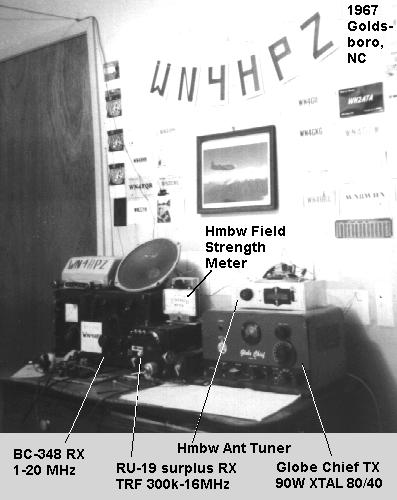
| all about Monty, N5ESE |
I took my test at the FCC office in Raleigh, NC, and after 8 agonizing weeks, early in 1967, my novice ticket arrived. WN4HPZ... wow, who could ask for a better callsign? While I was waiting, I acquired an RU-19 pre-WW2 TRF-tuned receiver for $20. It was tuned via a 12-foot speedometer-type cable, had gigantic plug-in coil modules, and was broad as a barn. But it had superb audio fidelity and was quite sensitive, so I felt like I was in high ham heaven. I then built a one tube "Cheap and Easy" CW rig from a CQ (I think) article. It was powered directly from the 115V AC line voltage, so it needed no transformer, but you really did have to be very careful not to touch brass while you keyed. Of course, I waited until I had my ticket, and fired it up with a 40 Meter crytsal. It lit up a 7-watt light bulb dummy load quite nicely, so I tranferred it to the long-wire ant I had strung up over the house and back to the basketball goal post. After several fruitless CQ's, I got a call on my landline from my mentor, Mike. Turns out he and his family were watching TV in their home a mile away, and all they could hear was the "clicking" from my new homebrew transmitter. I should QRT immediately, he says, and deal with it tomorrow. The next day, we visited another local ham (call forgotten), an old-timer with a garage full of equipment, and he loaned me a BC-348 receiver and Mike loaned me his Globe Chief transmitter and a handful of crystals to get my station underway. Finally, my first QSO, on 80 Meter CW! I spent every spare moment, til the wee hours of the morning, polishing my CW skills, and filling my log with QSO's. The picture below is of my first station in Goldsboro, N.C .

In the ensuing months, I built (successfully this time) a multiband transmitter, and acquired two WW2 surplus command receivers (BC-455 and BC-453) which were converted to a 40-Meter CW receiver with a tunable IF. My father (who was an NCO in the Air Force), was transferred in January of 1968 to Loring AFB, in the very northern tip of Maine. We had to live on-base, and I could not get on the air until I got permission from the base commander to erect an antenna and operate a radio within the boundaries of the Air Base. This involved submitting drawings of the proposed antenna, and getting it reviewed by the communications officer and the MARS commander, as well as other paperwork. A month later, I was approved and on the air. It was a very interesting experience. 80 Meters CW had been my favorite band in N.C., but it was sometimes difficult making contacts on 80 from way up there, and I shifted my activity to 40 Meters CW. I also upgraded my license from Novice to Conditional (the equivalent of General, but the test was given by a volunteer examiner because I lived more than 300 miles away from the nearest FCC office), and got the call WA1JNC. I acquired an old Vibroplex bug for $7, as my CW was getting fast enough to limit me on the J-38 Straight Key my uncle had given me (which, by the way, I still have). I was immensely popular on the 40 CW band, because I was in a rare state (Maine) and a very rare county (Aroostook County), and county-hunting and W.A.S. were very popular at that time. I did tons of operating, all CW, and mostly ragchewing. My homebrewing took a backseat to operating, because as a teenager I had no money, and there were practically no hams around to mentor (or supply) me. The picture below was my station in Maine, where I operated for about a year.
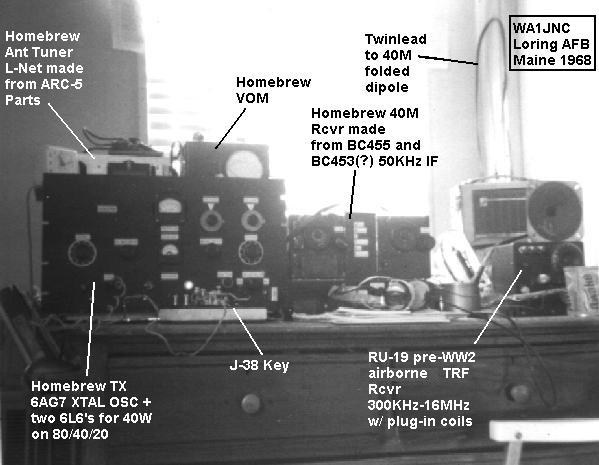
When my father retired from the Air Force in 1969, we moved to Maine, NY (the town of Maine, rather than the state). I once again set up my staion in my bedroom, and joined Air Force MARS, callsign AFB1JNC, operating on the CW net in the 6.9 MHz vicinity. RTTY was already the preferred mode for handling traffic on MARS, but the CW net handled a little bit, and it was good experience in directed nets. As it turned out, the closest MARS station was in Rome, NY, about 90 miles north of me, and so I had little opportunity to acquire free equipment. It was just as well, because I met my future wife in high school, and ham radio took a back burner for quite some time. We were married at age 19 (she was 18), and I never set up my station after moving out of my parent's house. I'm not even sure what happened to all that old equipment.
After my son's birth in 1974, I joined the Air Force for a 6-year stint, and was transferred to Bergstrom AFB in Austin, TX (where I still live). Around '77 or '78, the FCC had instituted "incentive licensing", and would grant a 1X2 call and full operating priveleges to anyone with an Extra-Class license. I had let my ticket expire, and this was all the incentive I needed to get going. But I needed a rig, and so I built the Heathkit HW-7 QRP transceiver. QRP was just becoming popular enough to be commercially viable, and the HW-7 was Heathkit's foray into that marketplace. After a few months of practice and study, I travelled to Brooks AFB to take the FCC- administered tests, and 4-weeks later I received my Extra Class callsign, and my First-Class Radiotelephone License with Radar Endorsement (talk about an albatross!). My assigned call was a KA5-something call, if I remember right, and I hated it, and immediately applied for my 1X2 callsign. About six weeks later, I was issued my callsign, N5FC, which I held until my current call (about 25 years). I did a lot of 40 Meter and 15 Meter QRP CW operating, with great success, in spite of the HW-7, which had a less-than-swell receiver. I build a Heathkit GR-78 shortwave receiver, which actually performed better than the receiver in the HW-7 (I still have the GR-78). I also built a band-switched solid state 15W amplifier (built around a Motorola MRF449 RF power transistor) to get me over the rough spots. At one point, I acquired a Johnson Viking Valiant transmitter (what a boat anchor!) but at 300 Watts CW, I found it scary, and a little too easy. During this time, I and Lew Fay AA5Q (now SK), organized the '79 Spring Eyeball (and a couple of subsequent ones), which met in Fort Worth to allow an opportunity for 30 or so regular 40 Meter CW ops to sit down and chaw eyeball-to-eyeball. Around this time I built the Heathkit HR-1680 Receiver and matching HX-1681 CW Transmitter. This was the best Heathkit pair I'd ever used for CW, with flawless QSK. I recently ran across this picture of me operating in South Austin, using some of this equipment:
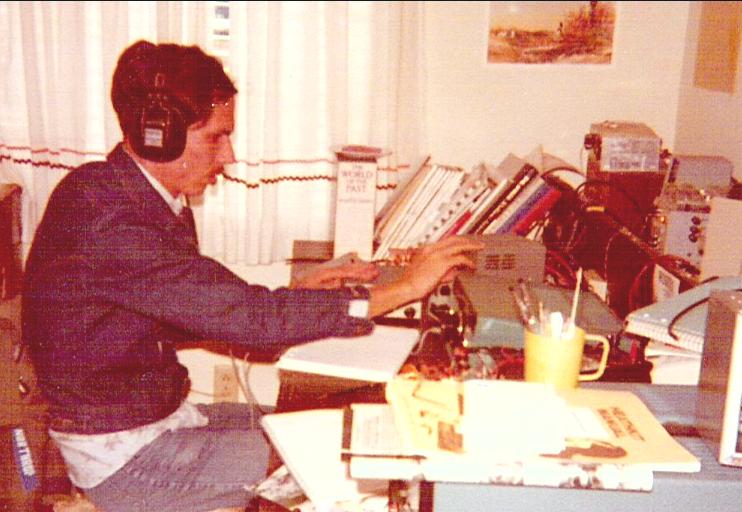
At the time this was taken, I had not yet acquired the transmitter of that Heath pair, and was still using the HW-7 and homebrew amp as my TX.
In 1981, I got out of the service, moved across town, and built the Heathkit HW-5400, a synthesized SSB/CW HF transceiver with a solid state final. It wasn't particularly popular among hams, but it did a good job for me for several years. For most of these years, I used a homebrew CW keyboard, built around 4000 series CMOS chips, using a design by a friend of mine, Harry W5DF (now SK). I found years ago that the muscles in my fingers would not go any faster than about 25 wpm (even with an iambic paddle), even though my cw copy speed was in the 40-50 wpm range. Here's a picture of that shack, circa 1982:
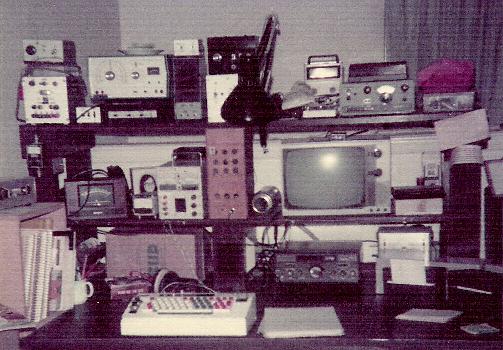
Now, here's a mystery, or at least proof of my failing mental condition. Recently, I was scanning some old family negatives, when I ran across a picture of my operating bench, with a rig I don't remember ever owning or operating. Haw! Yes, I've totally lost it... but that's my bench and equipment. Trouble is, I can't even identify the rig, and the negative is too grainy to read even the manufacturer on it.
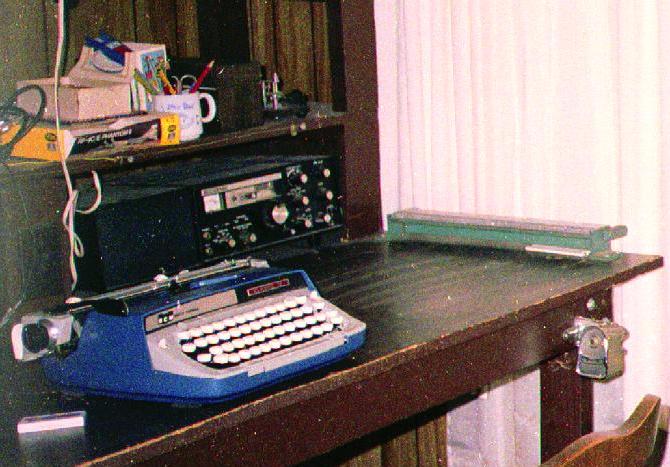
UPDATE: Mystery solved! Ed, K5BOT correctly identifies this as a Tempo One. When he told me that, the neurons started lining up all in a row, and I remembered that I acquired it from the widow of a close friend and a regular on 40M some years back, Lew AA5Q. I also remembered it was one of the worst CW rigs I ever used, and it got maybe one or two days' use before being relegated to the shelf to gather dust. At the time, I didn't even own a mic, so I can't say how it worked on SSB.
But I digress...
In late 1982 my father died, and I launched into a long period of inactivity in ham radio, spending most of my spare time doing volunteer woork for the local hospice organization, and eventually for the Center for Attitudinal Healing. In 1989 I separated from my first wife, and in that process (i.e., starting over) gave away all of my ham gear (all of it!).
Eventually, I re-started in ham radio, purchasing an old Ten Tec Century 21 CW transceiver for my main rig, which still serves that purpose. I also got back into homebrewing, which probably comprises 75% of my current ham activity. Since I was starting from ground zero again, my first project was an iambic keyer, based on HC-series CMOS chips. In 1998 I built the Jade Products SLR-40 receiver kit, so that I could have something to drag around in my suitcase when I travel on business (which is a lot, lately). I was really disappointed in the performance of the shielded antenna that came with the SLR-40 kit, so I built one out of a wooden embroidery hoop, and sticky-backed copper tape. You can see all about my loop antenna -here-.
Below is a semi-recent picture of the operating position at N5FC.
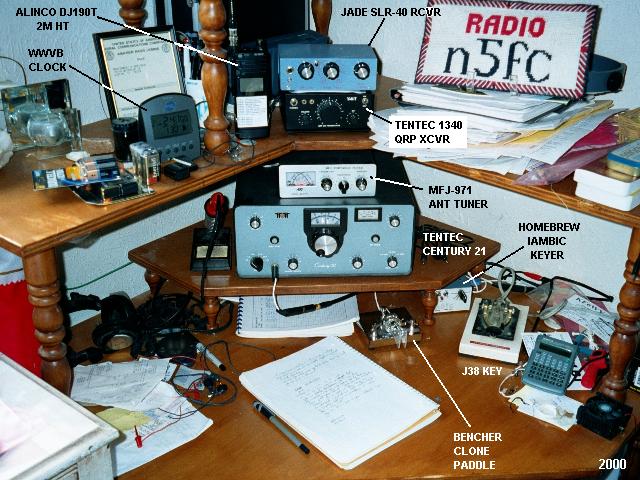
I had big plans to enter the 2N2222 contest in Dayton sevral years ago, but couldn't quite pull it off in time. I still want to build that project (I have the parts in hand), but if you want to get a jump on me, here's the paper design.
In spring of '99, Tech America (now, no more) had a sale in which the Alinco DG-190 2-meter HT was priced below $100. I took this as my cue to get involved in local (Austin) VHF FM, and bought my first microphone in 30+ years as a ham. It's been very interesting to meet local hams on-the-air and in person for the first time, as a result of this activity. Austin has a great bunch of friendly and helpful hams, and a lot of local activities. I also carry the HT on business trips, hooking up to a quater-wave mag mount which I throw on the roof of my rental car, or use on top of the microwave oven in my hotel room, or with my homebrew portable ground plane. Wanting a little more performance, but not wanting to spend much money, I purchased a Kenwood TM-261A for my car. It has performed superbly. One of my biggest problems with mobile FM for me is concentration while operating while driving. I'm still struggling with that one, so I'm more likely to be listening than talking, although if the traffic is light I will often get on the local 146.94 repeater.
In summer of '99, I participated in Field Day in the single-op single-band QRP class. I only lasted 20 of the 27 hours, but I garnered enough points to have the highest score in my section (for my classification). We went full out, erecting a portable mast and inverted vee for 40 Meters in the early hours of the exercise, and operating only on solar-charged batteries. For my transceiver, I used the Ten Tec 1340, which I had put together in the previous two weekends. With 3 watts out, it did a marvelous job for me, and the receiver was a particularly nice superhet design. Here's a picture taken in the wee hours of the morning, as I made contacts during Field Day:
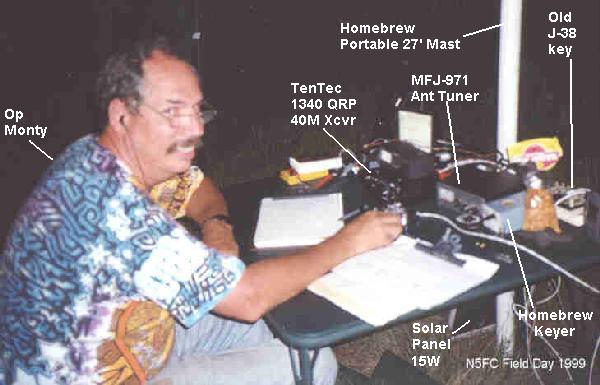
One of my favorite discoveries is the Austin QRP Club; I've been attending meetings since October '99 and having an absolute ball! And here's a picture of me with some of the guys at one of the AQRP Club meetings. In June of 2000, 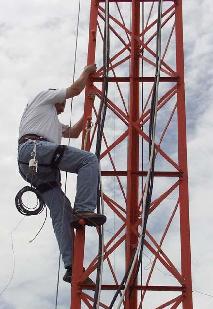 we participated in field day under the auspices of the Austin QRP Club, using call KQ5RP, and made a pretty decent showing in our class. The location was "secret", but suffice it to say it was primo ham radio territory. Here's a picture of a spectacular sunrise on field day morning: (nuff said?)
we participated in field day under the auspices of the Austin QRP Club, using call KQ5RP, and made a pretty decent showing in our class. The location was "secret", but suffice it to say it was primo ham radio territory. Here's a picture of a spectacular sunrise on field day morning: (nuff said?)
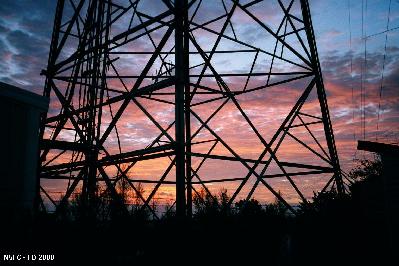
 In 1999, via e-bay, I acquired a TenTec 555 Scout SSB/CW transceiver, with plug-in modules for 80, 40 ,30, 20, 15,and 10. It's now my main rig. It has a really hot receiver, with an interestiing and useful "JONES" variable-bandwidth crystal filter. You can see some spectographs of the receiver bandwidth -here-. At 2.5" x 7.25" x 9.75", it's also very small, can be operated at 5 W or 50 W and highly portable (though it's somewhat of a power-hog). I modified it to switch at will between QRP and 50 watts, which makes it great for QRP and portable ops. I occasionally pack it in my suitcase for business trips, and operate off a 7 AH gel-cell battery.
In 1999, via e-bay, I acquired a TenTec 555 Scout SSB/CW transceiver, with plug-in modules for 80, 40 ,30, 20, 15,and 10. It's now my main rig. It has a really hot receiver, with an interestiing and useful "JONES" variable-bandwidth crystal filter. You can see some spectographs of the receiver bandwidth -here-. At 2.5" x 7.25" x 9.75", it's also very small, can be operated at 5 W or 50 W and highly portable (though it's somewhat of a power-hog). I modified it to switch at will between QRP and 50 watts, which makes it great for QRP and portable ops. I occasionally pack it in my suitcase for business trips, and operate off a 7 AH gel-cell battery.
Here's a 2001 picture of the shack, which occupies one corner of the master bedroom... click on the image for an annotated version detailing the equipment shown. Some of my recent projects can be seen in the stack of equipment. OK, OK... I ain't known for being neat (the XYL reminds me all the time).
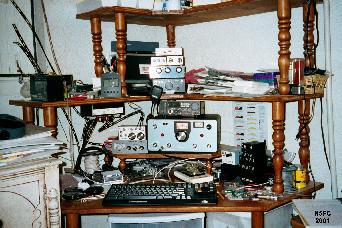
Field Day 2001 with the Austin QRP Club was great fun; we were foiled by lightning for a while, and had to abandon ship for several hours, hurting our score, but it was great fun nonetheless. Here's a picture of me at the paddles with N5WU's K2 (what a great QRP rig!)
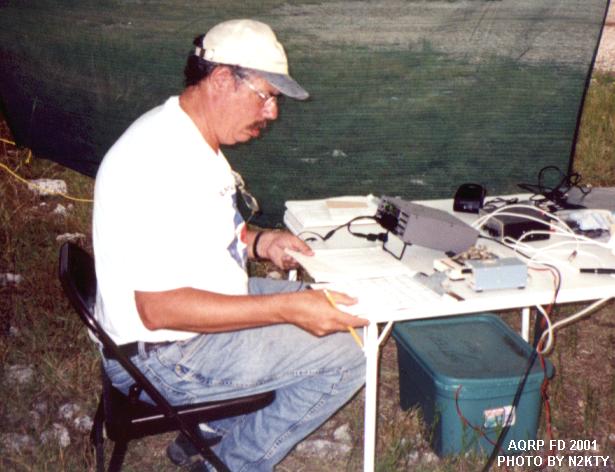
Field Day got me spun-up for portable ops, and since then I've spent more time operating portable outdoors than I have operating from home. Here's a picture, taken by my wife Carolyn, of me operating from a unique location in the mountains of northern New Mexico.
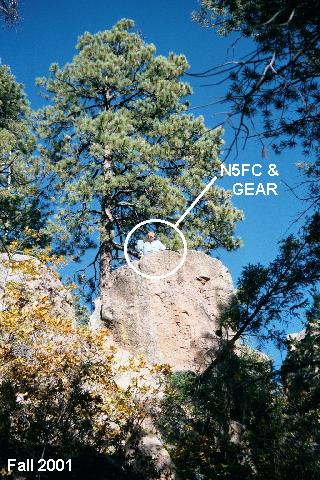
On this particular outing, I was able to work a JA for about 15 minutes, using about 2 watts from my TenTec 1315 transceiver on internal batteries, with an RFD antenna. He was also at a high altitude (around 9000 feet), and commented that we might be line-of-sight HI HI.
In June of 2002, I built the Elecraft K1 CW transceiver. [20 years hence, it's still one of my favorite rigs.] - With 4 bands and a built-in Automatic Antenna Tuner and internal battery set, I found myself itching to be in the field more and more. In the following picture, you can see how self-contained the unit is... even the Palm Mini-Paddle mounts to the side of the K1.
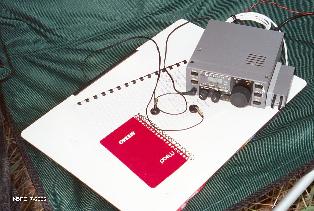
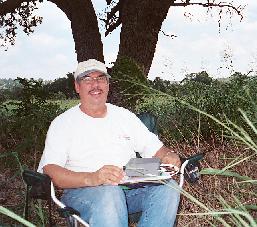
Above right, you'll see a picture of one such outing, during the Adventure Radio Society's "Flight of the Bumblebees" QRP contest in 2002. Let it be said right here that I am no contester. In fact, my bumblings during this contest earned me the distinctively low honor of being nominated and unanimously accepted into the Second-Class-Operators Club. Somebody said it was because I was calling "CQ BB" for hours on the day before the contest... NAW! I didn't do that, did I?
In December of 2002 I ran into Lloyd, K3ESE, a fellow QRPer, and we had a grand ragchew, talking about our experiences with our respective K1s and Rock-Mites. But what made this QSO so unique, and surprised me as much, was the amount of fun I had sending his "shave-and-a-hair-cut" call. I was so enamored, I actually looked to see if 'N5ESE' was available in the Vanity Call System. Lo and behold, surprise of surprises, it was! And on Jan 3, 2003, I gave up my dear, longtime, cherished 1x2 callsign N5FC, and acquired my new baby, N5ESE. (I hope I haven't done something rash... but it won't be the first time...)
I continue to build radio gear all the time, and typically get on-the-air only once-a-week or so. My current (and maybe oldest) homebrew project is the 2N2222 transceiver. It's about 2/3 complete, and so far about 25 transistors (all '2222's of course)... keep your eyes peeled on this site for pictures and schematics...
Lately, in large part because the Elecraft K1 and KD1JV's AT-Sprint make it so easy, I've done a lot of portable QRP operation. In fact, in the past year and a half, I've logged more Q's from the field than from home. I don't document all my trips, but if I get pix, I try to post my most recent one -here-. QRP ops have become a favorite pastime, and if I'm not using the K1, I'm using the AT-Sprint 3-bander in conjunction with a pocket-sized Elecraft T1 Automatic Antenna Tuner. I'm a big fan of compact, elegant designs, and these definitely fit the bill. They also make getting on the air anywhere you go about as easy as it can be.
During Austin Summerfest 2003's QRP Forum, the Austin QRP Club, spearheaded by Glen Reid K5FX, surprised me with a public presentation of a trophy, which you can see -here-. Thanks, y'all.
In the summer of 2004, after years of lusting, I built the Elecraft K2, just in time for Field Day. Impressive receiver. Most recently, I added the Audio DSP board option, which is pretty impressive (especially so for reduction of man-made noise). I also added the SSB board, though my intention is to use it on PSK31, as I'm not crazy about phone ops.
In April of 2007, the XYL and I moved out of the city and into the boonies of Central Texas. It's quite an adjustment after 30+years living around interminable power line hash noise (and being unable to work 80 Meters), to living in an area where the noise is almost completely dictated by atmospheric conditions and weather. To top it off, we have a little acreage, and for the first time in my life I can put up a hellaciously long wire antenna if I have the inclination to. Right now (2008), I have two crossed doublets at 40 feet, each fed independently with 300-ohm ladder line. One is 350 feet long, and the other 88 feet long. What a luxury!
Unfortunately, between work and yard maintenance - I was totally unprepared for the amount of effort keeping up 4 acres is - I have little time for home-based operating. To illustrate this point, here, after over a year, is how much progress I've made getting the ham shack unpacked:
Commuting back and forth to work, an hour each way, I still got a good deal of operating in. So nearly every day, Monday through Friday, I fired up the rig-of-the-day (propagation gods willing) on 40, 30, or 20M. Even though I started every QSO at QRP 5 Watts, using only a mag-mounted mobile dummy load (hamstick) on my big steel road boat, I was daily amazed that I could get 2 or 3 QSOs on almost every trip, and typically one of those would be a ragchew! Ain't radio mysteriously, wonderfully fun? Here's my typical /M setup from way back when:
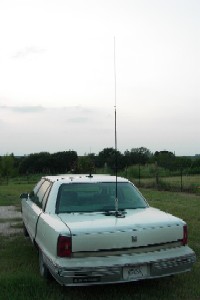
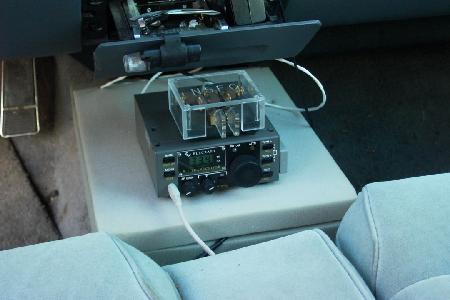
Life often has its own plans, which it executes without consultation. In late 2012 my wife Carolyn became ill, and early the next year, she passed away. Suddenly, ham radio didn't seem important to me, and there were several years devoid of any operating or homebrewing.
Then, in 2014, I finally realized that work had stopped being fun, and I retired from my day job. Therafter, it seemed I spent most of my time trying to keep up with the duties of home and 4 acres in the country near Lockhart, TX. After I met my future wife Julie in summer of 2015, we tried to maintain two households (one in the country, and one in the city), and we found ourselves in total overload. Things slow down as you age, and one's ability to maintain the pace of younger years diminishes. Not complaining, mind you, but I found I just couldn't keep up with the country property, and I let it go in 2020, grabbed my faithful dog and cat, and moved back to the QRN - I mean, the city ;-)
Without the daily travel back-and-forth between houses, my free time and my interest in ham radio returned. I explained to my new bride about my first wife (ham radio), and she pretty much said "OK, but just leave me out of it"...HIHI. In short order, I threw up a wire, and commandered a small 9x4 ft closet in our little 1940's home, and constructed the new shack. Here's a picture from 2017, and it pretty much looks the same today (except way more messy):
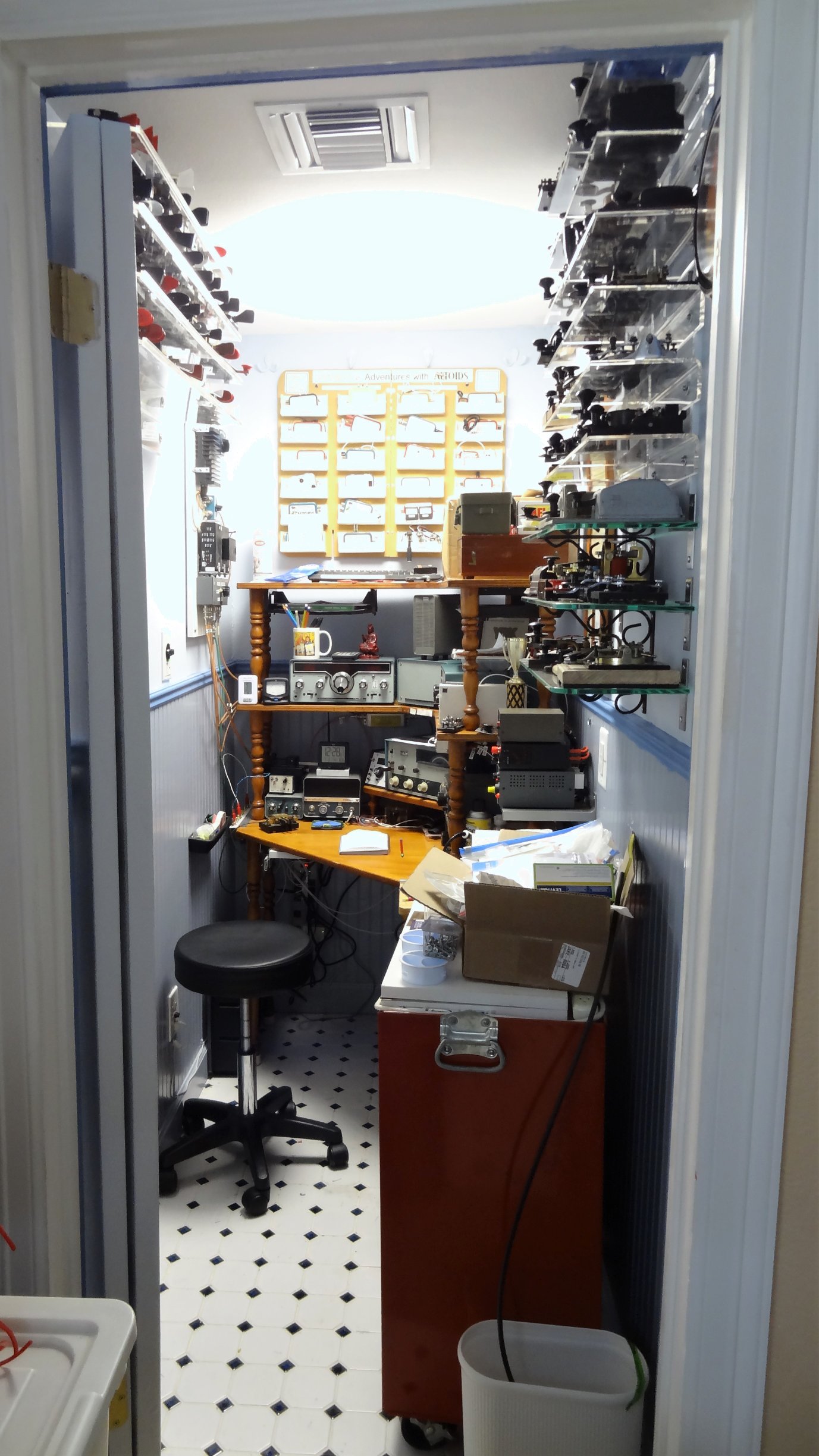
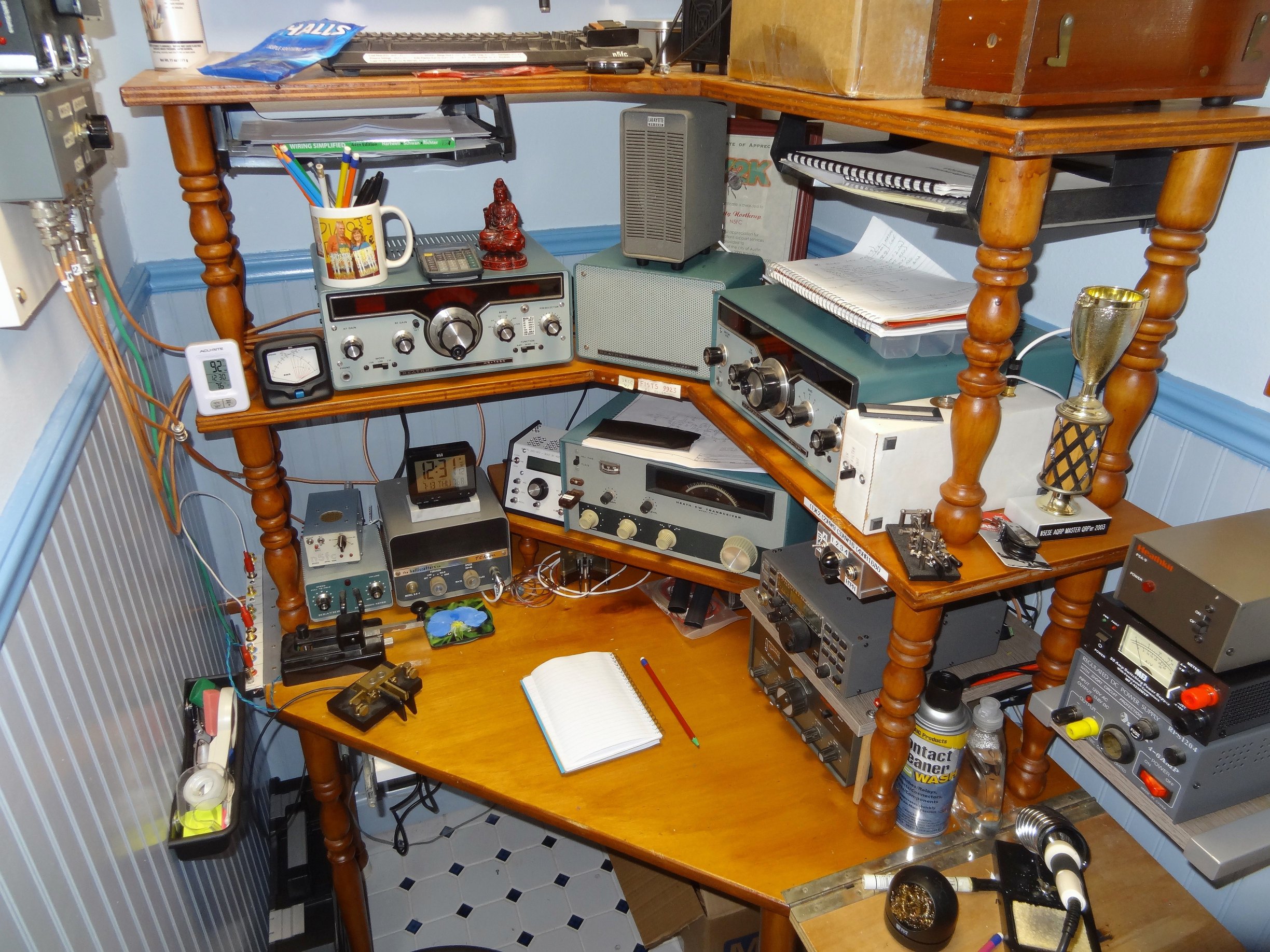
Most of my activity now centers on designing/building radio gear and test equipment, kit building, and repairing/restoring old boatanchors. I'm especially adept at starting new projects and *not* finishing them (before I start another HIHI). Consequently, I have a lifetime of projects in progress, and my retirement pretty much revolves around "honeydoos" and the ham "project du jour". I still love to operate, especially CW ragchewing, but the brutal reality of it is that I fill out only about one or two logbook sheets a year. When I travel, I always drive, and I always carry a QRP rig and some wire in my field kit, so you might hear my call from most anywhere.
If you're interested in a QSO with me, shoot me an e-mail. I can generally work 40-10M anytime. 80M mainly local, because of the small back yard and the short, low wire here. I'm usually QRP 5W, but I'll bump it up by 10dB if needed. My current main rig is my kit-built Elecraft K2/100, but you'll often hear me running my old 1970-ish Heathkit HW-16 or the Heath CW Twins from later the same decade.
Feel free also to fire off an e-mail to me, and request a CW sked 80-10M. We'll do our best to accommodate you.
73,
monty N5ESE
dit dididit dit
Copyright 2003-2023 ...[ view copyright info ]...